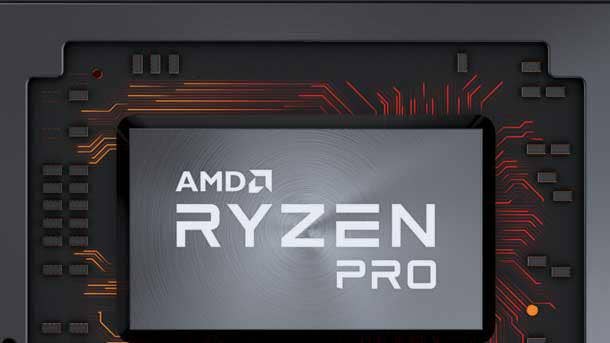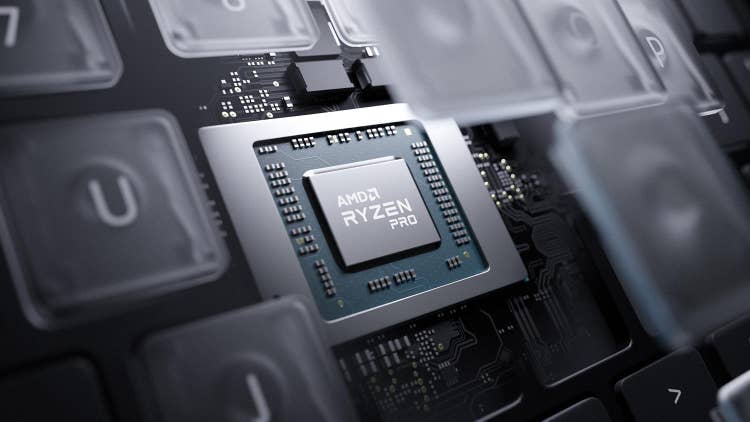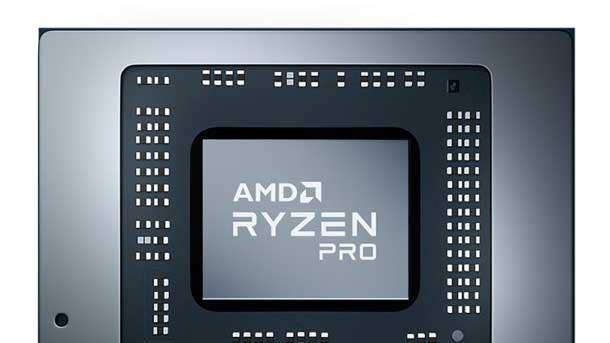For AMD’s Commercial PC Head, Patience Begets Ryzen Pro Growth
In an interview with CRN, Matthew Unangst, senior director of AMD’s commercial client and workstation business, talks about the work it takes to convince large organizations to switch to PCs using the chipmaker’s Ryzen Pro processors.

‘It's About Steady, Consistent Growth’
AMD is making headway against Intel in the commercial PC market as Fortune 1000 companies and public sector customers adopt fleets of PCs with its processors. But convincing such organizations to switch from Intel-based computers sometimes means years of waiting and a whole lot of patience.
“The commercial market is not one that’s driven by bursts. It’s not these quick-turn types of ’here now, gone tomorrow’ opportunities,” said Matthew Unangst, senior director of AMD’s commercial client and workstation business, in an interview with CRN from earlier this year.
[Related: AMD Hires Tech Data Vet Marty Bauerlein To LeadVAR Business ]
Instead, Unangst said, it can take years for organizations to evaluate PCs running AMD’s Ryzen Pro CPUs before they decide to make a large volume purchase of AMD-based systems. It’s a big decision for organizations to make, given the importance of not just performance but also the silicon-based security and management features that many commercial customers now expect, areas where AMD is now providing solid competition against Intel, according to Unangst.
“It’s about building customer mindshare. It’s about proving that you’ve got the right technology. And we’re seeing customers come on board now that we’ve been engaging with for a couple years. They’ve been evaluating, evaluating, evaluating and now they’re ready to pull the trigger,” he said. “And so it’s not this step function uptake all of a sudden. It’s about steady, consistent growth, quarter-over-quarter, and making sure that we’re delivering the products and the capabilities that our customers want.”
AMD CEO Lisa Su said in late October that the chipmaker experienced year-over-year growth for the commercial PC business in the third quarter thanks to customer wins in the public sector as well as with technology, energy and automotive customers in the Fortune 1000. The company also saw “strong growth” in the workstation market with its Threadripper Pro CPUs, she added.
This contributed to double-digit year-over-year growth for AMD’s client computing revenue in the third quarter. It also helped the chipmaker reach 24.6 percent share in the x86 CPU market against Intel, the highest it’s been since 2006, according to Mercury Research.
In his interview with CRN, Unangst talked about why AMD is winning business from large commercial customers, how the chipmaker is putting a greater emphasis on collaboration and security with its new Ryzen Pro 5000 CPUs, how AMD is working with developers to optimize software on its CPUs and where he sees opportunities for desktop PCs in the commercial market.

Does AMD have a read on market share for commercial notebooks and desktops? And if so, what are the trends for AMD's commercial notebook and desktop share?
I can’t get into specifics around the share numbers, but certainly we do keep a close eye on where our share is going on the commercial side, both in the notebook and the desktop side. And we actually share this, it’s public information: If you look at our share over the last three years in the commercial side, we’ve more than doubled that in commercial overall, and we have very strong growth there specifically on the notebook side. What I would say right now, especially in the commercial space, we are very focused on the more premium and enterprise platforms powered by Ryzen Pro. There’s strong demand there. We’re seeing strong customer uptake and our expectation, absolutely, is that we continue to grow that business moving forward.
In a presentation you made in May, it said 2x for AMD's commercial business in 2020. Was that showing growth of AMD's commercial design wins, or was that showing AMD's market share growth in the commercial segment?
If I recall, in that presentation we shared a couple pieces of data there. One was the total number of design wins, and one was share growth. And those two things, to a large extent, go hand in hand. But they’re not always one-to-one, and so on both fronts there, we have seen very, very strong growth. If we look at design-win growth over the last three years, that is at a very, very strong clip of growth, with existing customers and adding new customers. And then if we look at the share growth, that 2x number from 2018 to 2020, that was the number that I think we shared.

So I did want to ask about customer wins. You were talking about how some customers have been evaluating the platform for a couple years and then they finally bought in. When it comes to these bigger customer wins, can you talk about the progression of those deals and how AMD enters the conversation? And who influences that conversation? Is it AMD? The OEM? The channel partner? What does that look like at the beginning?
It’s a great question, and the honest answer is it kind of depends. But at a high level, the way that we approach this is, it is absolutely a partnership between us and the OEM. So whether it’s AMD and HP, AMD and Lenovo, AMD and anybody else, it’s a partnership where both the OEM with their sales support as well as AMD with our sales support and our technical support go into a large customer. And this is especially true for large government tenders or Fortune 500 companies with large IT departments. We’ll typically engage them, share our technology capabilities, provide some demonstration units for them to integrate into their environment.
And what a lot of these organizations do is they run them through the paces. They run benchmarks. They run a number of applications within their ecosystem that are maybe unique to their organization. And they’re looking for the performance of the product. They’re looking to understand how that fits into their user needs. And they’re also looking at the security and manageability capabilities of those platforms relative to the way they deploy those solutions in their organization. So it’s not a one-trick pony type of thing. You really have to have the complete solution.
What we have certainly seen over the last couple years is, if I rewind the clock a couple years ago, like with our Ryzen 3000 products, we had a very competitive set of products, but it was oftentimes parity on a number of things. We won some. We lost some. As we moved to Ryzen 4000 last year, that improved, and we’re increasingly seeing our systems really come out on top. At least that’s the feedback from the end customers to us. Our systems are performing very well, they’re exceeding expectations, they’re delivering the needs on performance and battery life and security and manageability. We really are hitting the needs of that end customer.
And so I hope that gives you a little bit of a feel for it. There are other variables that come into play as we go through that sales cycle, but it is very much a partnership between us and the OEMs to go in there and support them, because we continue to invest in that space. As we continue to deliver products with increasing capabilities, we’re certainly seeing that pay dividends.

Are there any situations where the channel partner, like the value-added reseller or the solution provider, can influence the conversation?
Absolutely. And this is where the route to market or the right route to procurement and fulfillment of systems can play out in a lot of different ways.
Sometimes systems are sold direct to the customer. Sometimes they are distributed through the channel. And certainly there’s a number of larger companies out there, mostly small businesses but also large businesses, that actually do procure through the channel. So they do have that relationship with the distributors, with the resellers, and that’s why it’s important for us that we’re driving engagement and product awareness and marketing, not just directly with those end customers but also with our channel partners, and that has been a very strong focus of ours for the last couple years.
I think a few years back that, candidly, was one of our weak areas. We have very much made that a priority. We’re very focused there on building those relationships, and there’s always more work to do, but we’re very focused on continuing to broaden that partnership.
When it comes to customers that are buying Ryzen Pro-based systems, what are the main reasons they're buying? Is it the performance, security, or is it the manageability? What's most important to them?
Honestly, in the commercial space, I think it’s about that whole package. If you have the right features, but you don’t have good performance, or you have great performance but poor battery life, these enterprise buyers, they’re really looking for that “no compromises” solution, and that is where I think we’re really excelling right now.
We have outstanding leadership performance across real-world applications that the user sees and experiences. We have that leadership battery life. And then we have those AMD Pro technologies, so the user is getting a great experience, and the IT department has the security and manageability that they’re looking for. It’s really kind of a win for every stakeholder within that organization, and, as we look at our commercial business moving forward, that is absolutely where we’re going to continue to focus, making sure that we’re investing in all of those areas, and that we stay on the leadership side in all those spaces as well.

In the last few years, AMD has been talking about gaining more acceptance among customers. I know that from the various solution providers that I've talked to, there's definitely a lot more acceptance of AMD. But the commercial market has been an Intel-dominated space for a long time, especially in the enterprise segment. Is there a barrier at all with some enterprises not even willing to consider AMD? And if so, has that changed at all over the last few years?
I would definitely say it’s evolved. I think as we as we look at the aspects of driving that sales process that we talked about a few minutes ago, one of the pieces that’s absolutely critical is building that trust in our products and the capabilities of those products and our brand. We see that improving. We see the engagement level improving. There’s no question we have made substantial progress in the last couple of years in terms of product awareness, openness to purchasing the product and then transitioning into product preference. As we look at those customers, are we seeing more doors open? Absolutely. Are we having more conversations with them? Absolutely.
And I think we’ve certainly done a great job in Ryzen Pro space, but as we expand with our Threadripper Pro products for workstations, as we deliver more capable and leadership solutions in the server space, we’re seeing more and more of those doors open up as well. Because as a CIO or an IT manager or whatever, you are looking at how to outfit your entire enterprise with the best solutions holistically. And we’re increasingly able to offer that entire portfolio of products and as we have that set of offerings, those doors are opening up more and the discussions are getting deeper and deeper.
You said earlier that for some customers, it may take them a couple of years of evaluating platforms before they make the big purchase. How long does it typically take for a large customer to go from, "yes, we will evaluate," to, “let's make that big volume purchase?”
There’s just no one-size-fits-all answer to that to be completely honest with you. If we look at public sector and government opportunities, sometimes those take a little bit longer. Within large enterprises, it really depends on the organization. Sometimes that ebbs and flows with their budgeting cycles. Sometimes, as an example, when COVID hits and the entire world kind of gets flipped on its head, some of those decisions get made faster to move people off of desktops and onto notebooks. I wish there was a simple answer for you there, but there just isn’t, so you have to take it customer-by-customer.

Speaking of COVID, when we talked last, it was the beginning of the pandemic. Can you talk about how business needs changed with the pandemic and impacted commercial PC sales for AMD?
There’s a lot of pieces to that, so let me try to break that down into a couple key items to focus on.
First off, I’ll start with how COVID impacted IT departments’ needs and the ability to put the right technology into employees’ hands. I think it was a dramatic shift. We certainly saw a rapid shift in the industry towards laptops as opposed to desktops. Again, it doesn’t mean that desktop is never going to be around again. It just means that increasingly we’re seeing employees being outfitted with notebooks. And that’s in large part because a lot of people ended up having to leave the office and go work at home.
And so at an industry level we saw a rapid shift in that direction. We certainly saw that on the commercial side, no question about it. And that has definitely influenced the buying habits and the evaluation processes and all of that over the course of last year’s change.
Now as we look at the solutions themselves and how that’s driven changes, certainly, just like how we’re sitting here on this video conference right now, we’ve seen a lion’s share of business shift from in the office to all virtual. And so it has driven a very strong focus on the collaboration capabilities around these products. And when you look at delivering the best solutions there, it’s about how we go work with [independent software vendors] and application providers to make sure that our products are optimized for their solutions. And so whether it’s engagements with Microsoft on Teams or anybody else, we’ve been very focused on evaluating our products and working in partnership with those application providers to make sure that we’re delivering a great solution. And obviously you’ve seen them rapidly evolve the capabilities of their products as well.
So I think you know COVID shifted corporate buying habits, no question about it. COVID shifted the needs of a PC from an end-user perspective to being much more than it used to be. It is now absolutely an essential part of the communication and collaboration tool set every single day. It always has been, but now more than ever it is the centerpiece. And certainly, we’re confident in the capabilities of our products there, but we’re also very, very much focused on where that is going into the future and how we deliver some of the best experiences possible in those platforms moving forward.

AMD is working pretty closely with Microsoft on enabling some of the Ryzen Pro-specific features like Shadow Stack. But one thing I've noticed with Intel is that they have a pretty big software ecosystem and enablement team. What are AMD's priorities for software enablement in general for Ryzen Pro? Is there any focus on ISVs beyond Microsoft?
Absolutely. Great question. So, actually there are a couple pieces of that question. Let me tease that apart. First, to address the question around ISVs, we absolutely are committed and have R&D resources in place to partner with key ISVs. Obviously, Microsoft is always front and center, but as you look at other applications that are key in the commercial space, whether it’s Zoom or Adobe or a number of other things, we very much are driving those engagements. I think you see that on the client side and certainly as you look at the workstation and server side, there’s a broad set of ISV certifications that we go drive and enable. So we may not put it on a banner in the same way and say, “Hey, look at all the stuff that we’re doing here,” but we have a very strong organization around those ISV engagements.
And then more broadly, we do have a very strong focus on our software capabilities within the organization. I think our customers see that. Our partners — Microsoft and others — see that. And you can’t under-emphasize how important that is, because it’s not just about dropping a chip into a laptop. It’s about delivering the best experiences and the best solution to our customers. And that means delivering a leadership user experience on [Microsoft] Teams. One of the things that we highlighted when we launched the Ryzen Pro 5000 products was the fact that you could run Teams on one of our products — I think we had 40, 45 users on that — and then we were measuring performance of other benchmarks at the same time. And we’re delivering a leadership experience there. That’s not an accident. That’s happening because we’ve gone in, we’ve worked both internally around how we optimize our products but also with the ISVs to make sure that our products are working well there. Across that entire landscape, there is a very strong focus and commitment to make sure that you know we’re focused on that solution and delivering those leadership experiences.
You brought up desktop a few times. You talked about this as a market that isn’t really growing right now and that it's going to remain roughly the same size for the foreseeable future. What's your strategy there? Who do you expect to be adopting Ryzen Pro-based desktops?
Our expectation is that the desktop market stays solid but is smaller than it was previously. To a large extent, we see desktop demand recovering, in large part by geography around the world. And so there are certain geographies where we’re already starting to see it recover. Some of that has to do with personal preference or geographic preference. Some of it has to do with expectations around how and where employees work. There are a lot of factors that feed into that.
So as we look at that desktop market right now, we are seeing a geographic segmentation of that. There are other places where we continue to expect desktops to be strong, whether it be in call centers, support centers, stuff like that. So, certainly a little bit of a smaller market than it was before. But there’s still very much a core set of users that we expect are going to gravitate in that direction.

Looking back at the mobile side, AMD has had a nice yearly increase in design wins for the Ryzen Pro mobile processors. Is that design win growth expected to continue on that same trajectory next year?
I think there is certainly a strong opportunity, and I very much expect that it will continue to grow. I think if you look at the portfolio we have today, honestly, I could not be more proud about how much we have grown that. We have not only grown the number of platforms, but we have absolutely moved up the stack into much more premium platforms than we’ve ever been in before.
We’ve also added some new customers if you look at the commercial business. HP, Lenovo and Dell obviously constitute the bulk of the commercial business, and we’re engaged with all of those players in a very strong way. But as you look around the globe, there are some really, really important commercial partnerships to be made with other OEMs, whether it’s Acer, ASUS, Fujitsu, NEC.
And we’re very, very excited that we are bringing platforms to market with all of those partners focused on the commercial business. So we are expanding both in terms of customers, also in terms of platforms within each customer portfolio. And absolutely, I am encouraged that I think we’re going to continue to keep that momentum going.
I know that AMD has been doing more in the mini-PC space. Is that a focus for commercial at all, driving growth in the small form factor desktop space?
We believe that that’s where a lot of the desktop business is going. And as we look at the form factors in desktop, there are – and will continue to be – some customers that want the big tower. What I’m anticipating is that those larger towers more and more become workstation-centric, very high performance, very high capability. I’m expecting the bulk of the desktop market to move into more of those small form factor desktops, and we have some 1-liter desktop platforms in the market with Ryzen Pro. We actually have sub-1-liter if you look at the ThinkCentre Nano from Lenovo — I think it’s less than a half a liter. It’s a really cool little desktop platform. So, we have a number of platforms there, and that’s where we’re really continuing to drive our focus with those OEM partners because that’s the part of the desktop market that’s actually growing right now.